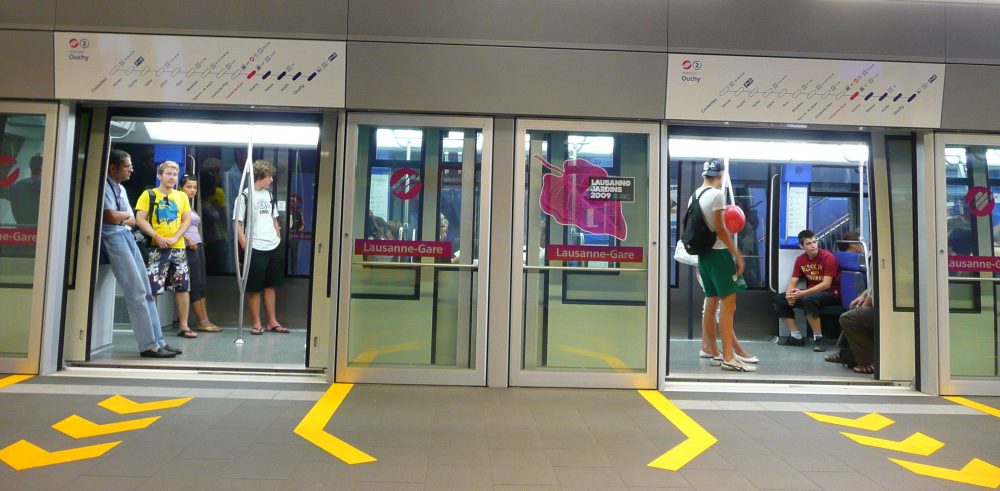by Danielle Robert and Maite Jorquera
Abstract
Our research objective was to see what the signs in the front display, including their windows, of food-selling stores could tell us about the demographic presence, the legitimacy, and the image of the foreign languages in Renens. Our corpus consists of pictures taken of such windows in a precise radius, except for one, from the Renens train station because of the strong presence of commercial ethnic production around. We choose to incorporate those stores in our corpus on the basis on their multilingual display on their store display. Once compiled, we categorize analyze our corpus from choice(s) of language(s), monolingual versus multilingual, top-down and bottom-up, the immediate context of the language presence and overall context of Renens and also considering Piller’s analysis of commercial discourse. Our major findings amount to underestimating the presence of some linguistics minorities, such as Turkish, Portuguese and Albanese, while overestimating it for English and Italian.
I. Introduction
The semiotic linguistic material of a city — all the signs, the posters, the building numbers, the graffiti — contributes to the construction of the public space. It gives the space sense and meaning and guides the observer in their interpretation of that space. This material makes up the Linguistic Landscape (LL). This study takes the approach of multilingual LL analysis with an interest in the relationships between the languages used in a certain public space, and the agency, identity, and spatial claim they express. We gathered a small corpus of multilingual signage found in the storefronts of ethnic grocers and restaurants around the Renens train station and analyzed their form, content, and context according to the categories set out by Mooney and Evans (2011) and following Piller’s guide to analyzing commercial semiotic material (2001). Our research objective was to see what the signs in these stores could tell us about the demographic presence and the legitimacy of the foreign languages in Renens. After situating our research in earlier work on commercial multilingualism and LL in immigrant neighborhoods, we will detail the specific geographical and demographic context of our study, and our methodology. The results of our study will then be presented and discussed, pointing out some of the incongruencies and the difficulties we encountered.
II. Earlier Work
Mooney and Evans (2015) discuss the relevance of studying LL to the mapping of a city’s demographic situation. LL is a telling reflection of the languages actually used in a space and their status with regards to the local official language. The use of a language marks its recognition and the power it holds. Mooney and Evans propose a series of categories for analyzing linguistic content according to its origin and its goals, which we exploited in the analysis of our research. Notably, they highlight the semiotic relevance of form: the form and support of a sign aid in the interpretation of its legitimacy. (Mooney and Evans 2015: 93-94). This is supported by Blommaert and Maly (2014), who analyze their corpus according to three axes: the production of the sign, the positioning of the sign, and the intended receiver. Blommaert and Maly (2014) cover a case study in the Rabot neighbourhood in Gent, Belgium. The case study is similar to our own in many ways, concerning a historically industrial zone that sprouted up around a rail station and is today superdiverse, socioeconomically disadvantaged, and about 50% foreign. (Blommaert & Maly 2014: 8) When signs appear to be aimed at populations that are not documented by demographic statistics, this reflects “local reflex of global change.” (18) We will see that this dynamic component of LL is also found in our study.
Piller’s work on multilingual commercial content was an important guide to our analysis. She points out that many scholars agree that “representations of society in advertising have their basis in the social order, but at the same time, this social order is constantly being re-created by reference to model discourses such as advertising.” (Piller 2001: 156) Borrowing from O’Barr, Piller distinguishes between primary resources, which communicate information about a product, and secondary discourses, which communicate meaning about the consumer society. There are some parallels to our case here as well, as Piller points to her English-German corpus to show that paralinguistic devices are frequently used to reinforce the authority of the English content, while simultaneously all the factual information (such as contact details) is in German, the standard language. (Piller 2001: 163) By applying these principles to our corpus, various photos of interest emerge that aid in our understanding of the construction of the LL in Renens.
III. Contextualization
Our corpus is taken from linguistic content in the storefront windows of ethnic grocers and restaurants, within a 500-meter radius of the Renens train station. This municipality is in the West Lausanne District with a permanent resident population of 21 114 (Atlas Statistique du Canton de Vaud , 2018). According to Piguet’s studies on immigration patterns in the Greater Lausanne area (1994: 65), the communes of Renens and Crissier housed more foreign residents in 1994 than any other commune in Switzerland, and today are among the communes of Lausanne with the highest concentration of non-Swiss inhabitants: 51.4% of Renens’ total population is of foreign nationality. While the municipal website claims over a hundred nationalities, the Atlas statistique documents the following: 14.8% of the total population are Portuguese, 7.6% are Italian, 4.7% are French, 4.7% are Serbian or Kosovar, and 3.9% are Spanish. It is worth mentioning that the municipal website offers all cultural and administrative information in a large variety of languages. According to the municipal website, this highly concentrated diverse population can be linked back to the arrival of the train station, in 1875. The rapid industrialization of the growing city brought many immigrant laborers over the course of the 20th century. The industry has been replaced by tertiary activities today.
Piguet (1994) identifies two very differently distributed immigrant populations in Greater Lausanne. The group of interest to this study is concentrated in the city center and West Lausanne, and originates mainly from Spain, Italy, Asia, South America, Africa, and Ex-Yugoslavia. In Renens and neighbouring communes where these populations are highest, 25% of the population had a revenue inferior to 29 900 francs/year in 1990. These communes also have a considerably lower average cost of rent and housing than those with higher concentrations of North European and North American immigrants. (Piguet 1994: 65) These characteristics help to explain the higher concentration of certain nationalities of lower socioeconomic status in and around Renens.
We were interested in Renens after observing a strong presence of ethnic restaurants and grocers, which is confirmed by the municipal website: food shops and cafés, bars, restaurants and take-away represent 35.5% of Renens’ economic fabric. We therefore chose to concentrate on ethnic food-oriented businesses, considering them to be plentiful and representative of Renens.
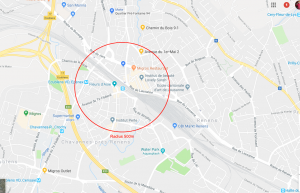
FIGURE 1. Boundaries of our corpus and selected establishments.
IV. Methodology
Based on the observation that the three most predominant linguistic communities in the Catholic parish of Renens are the Lusophone, the Italophone, and the Hispanophone communities, we expected to find evidence of these three communities in the LL. When we first went in search of evidence however, we were surprised to find little to no Spanish or Italian, but we did notice a large number of ethnic restaurants and kiosk-style small grocers. Further investigation into the demographic composition of Renens provided some insight. We decided to refocus our search on signs on the store fronts of these ethnic grocery shops and restaurants, in order to analyze what these signs could tell us about the demographic presence and the legitimacy of the foreign languages in Renens. We hypothesized that we would find Portuguese and Italian well represented, as the two largest immigrant populations in Renens, along with the presence of English, given the commercial orientation of our institutions of choice. We composed a small corpus of photos of fixed and temporary signs in storefronts that featured either multilingual signs or monolingual signs in more than one language. Signs include advertising of products and brands, the name of the store, posters for events, formal business information such as opening hours, menus, and information regarding social services relevant to the clientele. We then classified the signs according to several criteria, proposed in Mooney and Evans (2011: 87-98): (1) monolingual or multilingual, (2) languages present and their status (official, immigrant), (3) principle or secondary language in the storefront, (4) official or unofficial discourse, (5) regulatory discourse, (6) infrastructural discourse, (7) commercial discourse, and (8) transgressive discourse. Finally, we used the guidelines set out by Coulmas (2018: 137) to research the social, economic, historical and linguistic variables of the area.
V. Results
Our corpus of photos shows the presence of various linguistic communities. Figure 1 illustrates the languages identified and how many of the nine storefronts in our corpus present each language.
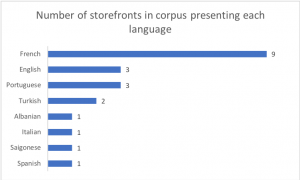
FIGURE 2.
French, the official language of the canton of Vaud, is omnipresent in the Renens LL. In Blommaert and Maly’s (2014: 8) case study in the Rabot neighbourhood of Gent, Belgium, they noted that Dutch was used in all top-down, infrastructural, and regulatory discourse, as well as serving as the lingua franca when a speaker’s linguistic background was not known. This is also the case of French in Renens. Due to the scope of this study, we excluded monolingual francophone storefronts from our corpus. Regardless, the occurrence of French in multilingual storefronts is constant: despite the variation in the amount of another language present, some practical information such as store hours is always displayed in French. English also figures in a third of the storefronts photographed, but is mainly present in brand slogans.
The presence of migrant languages in the storefronts ranges from being part of the name of the business, to having a more discreet presence, such as in the Turkish kiosk that only features one A4 advertisement on the window in Turkish and in French. Three storefronts have Portuguese content: a nonprofessional poster advertising a cultural event entirely in Portuguese features in the window of an apparently French tea-room, while two other advertisements in the Portuguese bakery are almost monolingually Portuguese, and another kiosk displays various window signs aimed at Lusophones such as a Catholic event ad and information to help Portuguese-speakers manage foreign fortunes in Switzerland. Two storefronts display Turkish content, including a travel agency poster entirely in Turkish, and another kiosk has an A4 typed notice both in Turkish and in French. While Albanian only appears in one storefront, this restaurant displays all information in Albanian, except the store hours which are in French. One business uses Spanish throughout its display and also gives the opening hours in French. Finally, one business displays the name of the store in Saigonese, a dialect of Vietnamese specific to the Ho Chi Minh City area, with all other information in French. This is also the case of an Italian pizzeria.
According to the categories used by Mooney and Evans (2011), our corpus is mainly commercial, with a few exceptions. Regulatory discourses are present when the store has the official “No Smoking” sticker, which is always in French. It is the commercial signs that present the largest variety languages. The choice of which language is central or peripheral (used beside the main language) in these stores varies. If we consider a language to be central according to the space it occupies in the storefront as a whole, much of the linguistic material in our corpus would be considered peripheral to French. However, there are exceptions.
VI. Discussion
On the presence and actual statistics of each language present in our corpus, we were surprised not to find more Italian signs in our radius, considering how large the documented population is. The Italian presence is connotational in our corpus, only present in the store name and indicating the type of store (“ristorante”) for symbolic value but doesn’t actually have much communicative value. All factual information is given in French. We were also surprised by a storefront presenting almost exclusively Albanian material, with the only exception being opening hours and “Watch the step” given in French.
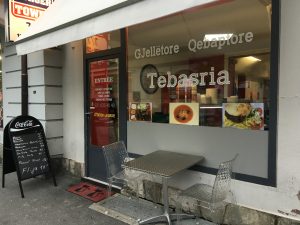
FIGURE 3. Albanian restaurant.
As non-Albanian speakers, it was impossible for us to identify what kind of restaurant this was without researching it. This is representative of the intended Albanian-speaking clientele. Despite the otherwise complete absence of this language from the LL of Renens, municipal data indicates that 4.7% of Renens’ population is of Serbian and Kosovar nationality. Despite this, only one Albanian-speaking food establishment is present in our radius, and we are unable to deduce the reason for this underrepresentation.
The form of some bilingual signs retained our interest. For example, there is one small advertising printed on a simple A4 sheet which announces a Turkish specialty at the top of the page in Turkish and then in French below.
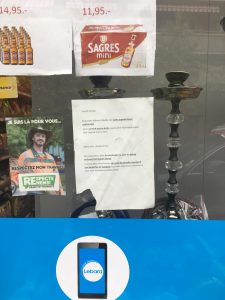
FIGURE 4. In a Turkish kiosk window: an announcement in Turkish above and in French below.
The handmade nature enacts the voice of the individuals that use this space, and the position of Turkish on the page makes a strong statement about the role of this language in this space. Statistically speaking, Turkish is overrepresented in our corpus as there are only 800 documented individuals in Renens according to the Commission Intégration Suisse Etranger Renens (2014), and yet our photos suggest that they have quite a visible and active community.
Two Portuguese-language signs in our corpus retained our interest due to the choice of language. In the bakery, Portuguese is very central inside the store and also in its front window, despite the name of the store being in French, and its window-advertising is mainly in Portuguese. While English appears in the event ad, its use is only connotational. One example of the reciprocal relationship between advertising and society (Piller 2001: 156) in our corpus is the nonprofessional Portuguese poster about a community event, because it portrays the author’s idea of what is appealing to someone belonging to a Portuguese linguistic community, for example by featuring typical Portuguese instruments.
As mentioned earlier on the English language present, it is mainly used in brand slogans, such as Evian’s “live young.” While Leeman and Modan (2009: 335) might argue that this is solely for the purpose of product recognition, Evian specifically is a French brand. Therefore, the use of English in their international marketing does support Piller’s theories on the use of English for connotational value (2001: 167-169) and transmitting ideologies, whereby this brand constructs an implied customer who is fit and healthy, and associates English to the truth and authority of the slogan.
Another use of an ethnic or immigrant language in the store name, common in our corpus, is in the Vietnamese street food shop with the shop name in Saigonese.
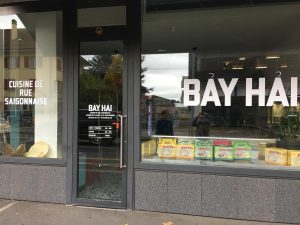
FIGURE 5. Saigonese street food shop.
The presence of this language suggests an invisible linguistic community in Renens, even though only 48 Vietnamese residents are documented as recently as 2014 (Commission Intégration Suisse Etranger Renens). The use of a Saigonese store name may act as a guarantee of authenticity and commodify Vietnamese street food for a mostly non-Saignose-speaking clientele (see Leeman and Modan 2009 on commodifying foreign languages). It is unfortunately impossible to confirm this hypothesis, as the business closed shortly after our corpus was composed and therefore so did the Saigonese population disappear from Renens’ LL. This recalls an example in the Blommaert and Maly (2014) case study; they emphasize the dynamic quality of the neighbourhood and the languages present.
Finally, two photos of interest catch our attention because of what they communicate about the expected bilingualism of the intended audience: the Turkish-only advertising in a kiosk window and the non-professional Portuguese-only advertising are both factual examples of how confident their authors are in their reception by the target linguistic audience, as French is completely absent from them. This is supported by Piller’s work as she argues that stores using the standard “[signals] doubt about the bilingual proficiency of the audience.” (Piller 2001: 163) It follows that the usage of uniquely monolingual content shows the producer’s confidence in the fluency of the targeted audience.
VII. Conclusion
Our research objective was to see what the signs in these stores could tell us about the demographic presence, the legitimacy, and the image of the foreign languages in Renens. We originally hypothesized that in addition to the official language of the canton, French, we would find Portuguese and Italian well represented, along with English in a commercial role. However, that is not what we actually found: English was effectively present in connection to certain products but less than expected. The presence of Portuguese and Turkish material was underestimated at first, as they make up the majority of the visibly multilingual ethnic food stores and restaurants we located. As for Italian, Spanish, and Albanian, they are only marginally present in our corpus, with one store for each. The presence of the Saigonese grocer also points to less visible linguistic minorities in Renens.
Overall, the presence of other languages in the LL of Renens is more discreet than one might expect, given that more than half of the population is foreign. We found that a number of establishments choose to limit their use of multilingual semiotic content to the store name and brand, suggesting that some foreign languages, such as Italian, are used connotatively for the cultural image that they communicate. This may speak to the legitimacy of immigrant languages in the public space. French is always used for official information and with a communicative value, versus other languages that often have a symbolic connotative value. There is however almost a second level of authenticity, as some languages claim their space in the public view via content solely available in an immigrant language. In other words, French is the authentic official language of francophone Switzerland, managing all regulatory and infrastructural discourse even here in Renens, but a number of other linguistic communities (namely, Portuguese and Turkish) are active and visible, and choose to claim their space in a superdiverse community with publicly visible content destined only for non-francophone consumption.
We can conclude from this study that the LL of Renens as seen in food establishments does not correlate entirely with the statistically documented demographic of Renens, with some important linguistic groups being almost completely absent, while overs are largely over represented. Besides French, Turkish and Portuguese benefit from a certain amount of legitimacy and presence in the public space, appearing in monolingual material or accompanied by French or English. French is omnipresent with a denotative and communicative value, while English is mostly reserved for use in brand recognition and advertising with a symbolic value. Other languages also figure in symbolic use, often in store names. Finally, the presence and then sudden disappearance of the Saigonese street food shop speaks to the “rapid social and cultural change [that] defines the superdiverse neighbourhood and its permanent demographic turnover.” (Blommaert & Maly 2014: 10)
Our findings are limited by the size of our corpus. It should be mentioned that just as there are a large number of Kebab businesses (at least six, according to Google Maps) that did not make it into our corpus for lack of multilingual content visible from the street. There are also many pizzerias and Italian restaurants around the Renens gare (at least eight). Also, our study was inconclusive on the reasons for under-representation of the Albanian linguistic community in the LL. Our choice to only focus on food establishments also influences our findings, as certain populations tend to find their niche in certain commercial domains. Our results would have been very different had we, for example, chosen to research languages present in the well over 20 hairdresser and personal grooming establishments within the same radius. Further investigation to deepen the understanding of linguistic choice in this LL could analyze a larger, more exhaustive corpus, or take a more ethnographic approach to the corpus already present, drawing whatever information possible from the users of these spaces, such as trying to reach out the owners with interviews or open questions for example.
References
- Canton de Vaud. (2018) Atlas Statistique du Canton de Vaud, Canton de Vaud par commune, Population résidente permanente, Statistiques Vaud. “Suisse et étrangers ; Portugais”. Available on: http://www.cartostat.vd.ch/#sid=116;sly=a_com_DR;l=fr;i=pop_natio.pop_ch_etr;v=map1;s=2017;z=529887,159307,10447,9646 . Accessed on: 03/12/2018
- Commission Intégration Suisse Etranger Renens, 2014. Rapport d’activité 2014. Available on: http://www.renens.ch/docuploads/vie_pratique/integration/pdf/CISE_Rapport_2014_WEB.pdf . Accessed on: 04/01/2019.
- Coulmas (2018), “Talk of the town : Language in super diverse cities.” in An Introduction to Multilingualism: Language in a Changing World. Oxford UP.
- Leeman J., Modan G. (2009) Commodified language in Chinatown: A contextualized approach to linguistic landscape, Journal of Sociolinguistics, 13.3, 332-362.
- Mooney A., Evans B. 2015. Language, Society and Power: An Introduction, 2, 4th Ed., 86-107.
- Piguet, E. 1994. L’immigration et ses espaces, Geographica Helvetica 2, 63-72.
- Piguet, Étienne. “Les théories des migrations. Synthèse de la prise de décision individuelle.” Revue Européenne des Migrations Internationales. Vol.29. n3. 2013. p. 141-161. Available on: https://journals.openedition.org/remi/6571#tocto1n3
- Piller, I. 2006. Identity constructions in multilingual advertising. Language in Society 30, 153-186.
- “Renens en chiffres.” Site officiel de la ville de Renens, Ville de Renens. No Date. Available on: http://www.renens.ch/web/portrait/articles.php?menus_pages_id=2&id=104. Accessed on: 12/27/2018.
- “Tissu économique renanais.” Site officiel de la ville de Renens, Ville de Renens. No Date. Available on: http://www.renens.ch/web/territoire_et_economie/articles.php?menus_pages_id=22&id=76. Accessed on: 12/27/2018.
